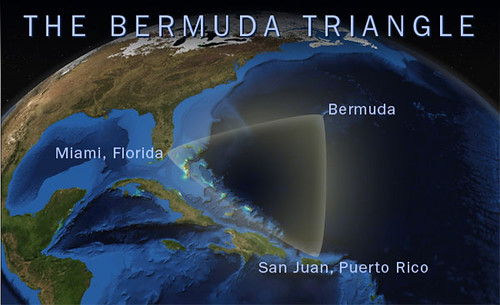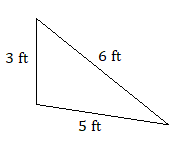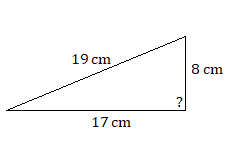Module 18: Triangles
 You may use a calculator throughout this module as needed.
You may use a calculator throughout this module as needed.
Classifying Triangles
We can classify triangles into three categories based on the lengths of their sides.
- Equilateral triangle: all three sides have the same length
- Isosceles triangle: exactly two sides have the same length
- Scalene triangle: all three sides have different lengths
We can also classify triangles into three categories based on the measures of their angles.
- Obtuse triangle: one of the angles is an obtuse angle
- Right triangle: one of the angles is a right angle
- Acute triangle: all three of the angles are acute
Exercises
Classify each triangle by angle and side. For example, “acute scalene”.)
1. 
2. 
3. 
Similar Triangles
In one of the diagrams in the previous module, the parallel lines included two similar triangles, although they may be hard to see.

Two triangles are similar if the three angles of one triangle have the same measure as the three angles of the second triangle. The lengths of the sides of similar triangles will be in the same proportion. The triangles will have the same shape but the lengths will be scaled up or down.
Exercises
Assume that each pair of triangles are similar. Use a proportion to find each unknown length.
4. 
5. 
Recognizing corresponding sides can be more difficult when the figures are oriented differently.
Exercises
Assume that each pair of triangles are similar. Use a proportion to find each unknown length.
6. 
7. 
Right Triangles
In a right triangle, the two sides that form the right angle are called the legs. The side opposite the right angle, which will always be the longest side, is called the hypotenuse.
The Pythagorean theorem says that the sum of the squares of the lengths of the legs is equal to the square of the length of the hypotenuse.

The Pythagorean Theorem
In a right triangle with legs ![]() and
and ![]() and hypotenuse
and hypotenuse ![]() ,
,
![]()
If you know the lengths of all three sides of a triangle, you can use the Pythagorean theorem to verify whether the triangle is a right triangle or not. The ancient Egyptians used this method for surveying when they needed to redraw boundaries after the yearly flooding of the Nile washed away their previous markings.[1]
Exercises
Use the Pythagorean theorem to determine whether either of the following triangles is a right triangle.
8. 
9. 
Before we continue, we need to briefly discuss square roots. Calculating a square root is the opposite of squaring a number. For example, ![]() because
because ![]() . If the number under the square root symbol is not a perfect square like
. If the number under the square root symbol is not a perfect square like ![]() , then the square root will be an irrational decimal that we will round off as necessary.
, then the square root will be an irrational decimal that we will round off as necessary.
Exercises
Use a calculator to find the value of each square root. Round to the hundredths place.
10. ![]()
11. ![]()
12. ![]()
We most often use the Pythagorean theorem to calculate the length of a missing side of a right triangle. Here are three different versions of the Pythagorean theorem arranged to find a missing side, so you don’t have to use algebra with ![]() .
.
The Pythagorean Theorem, three other versions
![]()
![]()
![]()
Exercises
Find the length of the missing side for each of these right triangles. Round to the nearest tenth, if necessary.
13. 
14. 
15. 
16. 
- The surveyors were called "rope-stretchers" because they used a loop of rope
 units long with
units long with  equally-spaced knots. Three rope-stretchers each held a knot, forming a triangle with lengths
equally-spaced knots. Three rope-stretchers each held a knot, forming a triangle with lengths  ,
,  , and
, and  units. When the rope was stretched tight, they knew that the angle between the
units. When the rope was stretched tight, they knew that the angle between the  -unit and
-unit and  -unit sides was a right angle because
-unit sides was a right angle because  . From Discovering Geometry: an Inductive Approach by Michael Serra, Key Curriculum Press, 1997. ↵
. From Discovering Geometry: an Inductive Approach by Michael Serra, Key Curriculum Press, 1997. ↵

